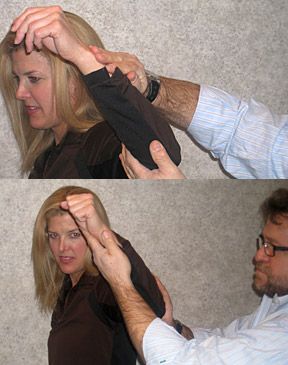New York's highest court of appeals has held that no-fault insurers cannot deny no-fault benefits where they unilaterally determine that a provider has committed misconduct based upon alleged fraudulent conduct. The Court held that this authority belongs solely to state regulators, specifically New York's Board of Regents, which oversees professional licensing and discipline. This follows a similar recent ruling in Florida reported in this publication.
An Important Shoulder Test Not Often Used
As I've said previously, most orthopedic tests for the shoulder cannot truly isolate a particular structure, since when we use tests that compress or stretch an area, adjacent structures also have to be compressed, stretched or contracted.1 While there is definite truth in this statement, most of us arrive at a diagnosis by using as many credible tests in the literature as possible. There is a test that, while not that specific in determining the exact lesion source, has the ability to determine whether the problem is located in a particular area, which can then be followed by other specific tests. The test is called the internal rotation resistance strength test (IRRST).2 This test, as discussed by Zaslav, helps to differentiate between an outlet impingement and a non-outlet impingement.
An outlet impingement is a primary impingement whereby the subacromial space is compromised, such as inflammation and thickening of the subacromial bursa, erosions on the coracoacromial ligament and undersurface of the acromion, and bursal-side partial or full-thickness tearing of the rotator cuff. Neer originally believed that 90 percent of rotator-cuff tears were due to structural primary impingement on the supraspinatus from the overlying coracoacromial arch such as a hooked acromion process, acromioclavicular spur, or thickening of the rotator cuff due to chronic calcium deposits.3 Unfortunately, many overhead throwers underwent acromioplasty with the diagnosis of a primary impingement rather than a secondary impingement due to instability.
A non-outlet impingement (intra-articular lesions) consists of labral lesions (SLAP), internal posterosuperior glenoid impingement, underlying instability and/or the loss of the normal obligate posterior translation with maximum external rotation or chondral lesions, and undersurface rotator-cuff partial tears.

The IRRST is performed with the examiner standing behind the patient, whose arm is positioned in 90° of abduction in the coronal plane in about 80° of external rotation. With the patient's arm in this position, the examiner performs an isometric muscle test for external rotation and then compares it to a test for isometric internal rotation. If there is good strength in external rotation compared to apparent weakness in internal rotation, the test is considered positive. The weakness in internal rotation might be an "apparent" rather than a true weakness. A positive test would indicate that there is a probable non-outlet intra-articular lesion, as explained above.
Zaslav first performs a Neer test to determine if there is any impingement to begin with.2 This test is performed by standing behind the patient. stabilizing the scapula and passively forward-flexing the internally rotated humerus. Zaslav explains that when the abducted 80° externally rotated arm is resisted in internal rotation, "a vector is created, pushing the humeral head anteriorly toward the glenoid rim and labrum. This force vector places tension along the biceps labral complex and along the capsulolabral border so that the pain from both subtle subluxation and biceps and SLAP lesions will be magnified in that position, causing the appearance of weakness. Pain will also be exacerbated in patients with true internal impingement because this forward motion reduces the obligate posterior translation that normally occurs with external rotation. This would cause rotator cuff contact between the superior glenoid and humeral head, resulting in pain on resisted internal rotation."2 A negative test (i.e., more weakness in external rotation) would indicate the primary subacromial outlet impingement.
In Zaslav's study, this test had a positive predictive value of 88 percent (patients with a positive IRRST with a secondary internal impingement as the cause of pain). There was a 96 percent negative predictive value (patients with a negative IRRST who only had an outlet impingement). The test was more positive in patients under 50 years who are at most risk for secondary internal impingement. Of 34 patients meeting those criteria, only two showed evidence of secondary internal impingement. Both patients had SLAP lesions. More clear-cut cases, such as a patient with a positive sulcus sign (usually indicating a multidirectional instability), positive apprehension sign relieved by the relocation test or no impingement sign, are usually easy to diagnose. It would be relatively easy to diagnose an older patient with primary impingement and positive rotator-cuff signs.
Zaslav feels this test is especially important for younger patients when we are attempting to detect a subtle form of intra-articular problem or instability. This may be a patient with a painful arc, indicating a subacromial problem and also a possible labral lesion (intra-articular) problem. The IRRST might help us decide which type of impingement is the prominent cause of pain and help guide our treatment.
References
- Hammer W. "How Valid Are Shoulder Tests?" Dynamic Chiropractic, Oct. 7, 2009;27(21).
- Zaslav KR. Internal rotation resistance strength test: a new diagnostic test to differentiate intra-articular pathology form outlet (Neer) impingement syndrome in the shoulder. J Shoulder Elbow Surg, 2001:23-7.
- Hammer WI. Functional Soft-Tissue Examination and Treatment by Manual Methods. 3rd Edition. Sudbury, Mass.: Jones & Bartlett, 2007:33-161.


